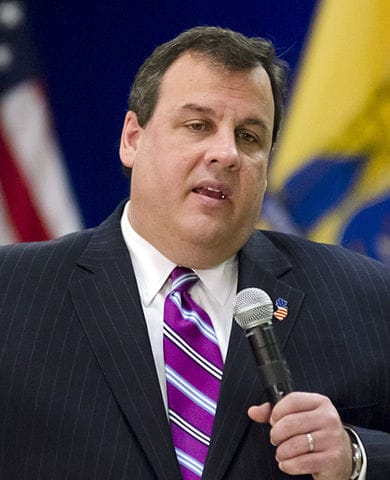The new teacher contract in Newark has rightfully caused widespread celebration. It has earned praise from New Jersey’s governor and education commissioner, Newark’s mayor and superintendent, local and national labor leaders, and many others. There seems to be a consensus that a new day has dawned for public education in this troubled city.
 Gov. Chris Christie has shown that he is committed to helping Newark schools improve. Photo from Wikimedia Commons. |
The history of urban school improvement efforts suggests, however, that we ought to temper our enthusiasm. The roadside is littered with much-ballyhooed but ultimately unsuccessful attempts to fix failing inner-city schools.
But if reform leaders are willing to exploit the opportunity that lurks in the Newark contract, this could turn out to be a pivot point in the nation’s decades-long effort to reform urban schooling.
This contract is an enormous improvement over its predecessors: It reforms compensation by prioritizing effectiveness instead of seniority. It speeds the implementation of improved teacher evaluations and enables change in the lowest-performing schools. It allows for greater school-level decision-making and removes bureaucratic barriers to reform.
The district will now be better positioned to attract and retain the best educators. Its leaders will have added flexibility to make decisions that meet kids’ needs. New Jersey residents will have greater confidence that state, local, and philanthropic funding will be spent in productive ways.
The agreement has also spawned plenty of strange bedfellows, bringing together management and labor, left and right. Local union president Joseph Del Grosso and national AFT leader Randi Weingarten cheered the contract. State superintendent Chris Cerf and district superintendent Cami Anderson lauded its transformative nature. At a signing event, GOP Governor Chris Christie called Democratic Mayor Cory Booker an "indispensable partner" and said, “This is the most gratifying day of my governorship.”
But there have been many similar celebrations before that were followed by the same dismal educational results. Why expect a different outcome this time?
The Newark school system now has everything it could possibly ask for: a reform-oriented teacher contract, a new state law on tenure and evaluation, per-pupil funding that’s double the national average, the $100-million Zuckerberg donation, partnerships with leading nonprofit organizations, freedom from a politically-motivated school board, a tough local superintendent, a reform-friendly mayor, the nation’s best state superintendent, an incomparably bold governor, and a vibrant charter-school sector nipping at its heels.
Yes, we should see this as the beginning of a new era. But we must also declare an end to the excuses. If Newark can’t generate dramatically better results this time, it never will—and one must wonder whether other cities can.
The governor should say so, and then put the district on the clock.
This was never an option in years past—the district was the only game in town, and leaders had to put all of their eggs in the district’s basket. There was no “or else.”
So when results came up short (as they always did), leaders had no recourse. The stubbornly underperforming district, having successfully weathered another passing storm of reform, would carry on as before, watching another set of vanquished elected officials exit, their heads hanging low.
But now an “or else” exists. It’s that vibrant charter sector—and not only in Newark. Indeed, we now know that the district is expendable. In New Orleans, three-quarters of students attend non-district charter schools. In Detroit and Washington, D.C., the number approaches 50 percent. In a dozen other cities, it’s more than 25 percent.
Said simply, chartering can replace the district—and this can happen in Newark, too.
Charters already have a 17-percent market share there and, more importantly, as a fine new study from CREDO shows, these schools are doing extraordinary work: Each year a student attends a Newark charter, she learns seven and a half months of reading and a full extra year of math more than her peers in traditional district schools.
The extremely successful charter networks KIPP and Uncommon Schools are already operating in Newark—and are prepared to grow there. The district has numerous under-enrolled buildings, meaning that there’s space within which charters can grow. A wide array of support organizations, including foundations and human capital providers, stand ready to advance the expansion of high-performing charters.
And most importantly, since the state has complete control of the district and the state education department is New Jersey’s lone charter authorizer, the state, at the governor’s direction, could lead Newark’s transition from a district-based to a charter-based system.
Let’s hope, of course, that the numerous arrows now in Newark’s quiver will enable that district to drastically improve student achievement. But we cannot allow ourselves to look back ten years hence and realize that the district devoured another set of reforms and remained as low-performing, obstreperous, and powerful as ever.
By selecting Cerf as state commissioner, faithfully backing Anderson as local superintendent, reforming tenure, supporting the new teacher contract, and more, Governor Christie has shown that he is committed to helping that district improve.
But for the sake of today’s and tomorrow’s children, there must be a Plan B. By putting the district on the clock and offering a new vision for urban public education, Governor Christie can offer a brighter future to Newark’s residents and, in the process, emerge as the nation’s most aggressive and forward-thinking education-reform governor.
A version of this post appeared in the New York Daily News and as a blog post on the Flypaper. For more about CREDO's study on New Jersey charter schools, see another of Andy Smarick's recent posts on Flypaper.